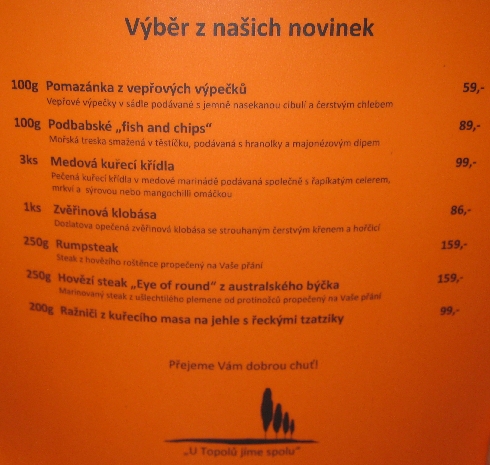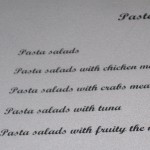
This evening, we went to eat at one of our favourite local bar-restaurants – U Topolu. The name means, ‘to the poplars’, hence the logo at the bottom of the menu in this photo. On each of the tables, there was this laminated card advertising various new additions to their main menu.
The penultimate item yet again had us in stitches. For those who cannot read or understand Czech, it is seeking to describe what, in English, would be called an ‘Australian rump steak’ or a ‘Rump steak from Australian beef’.
There was no supposedly English version of these additions to the menu. What you have here is Czech Czenglish – a menu in Czech, trying to appear sophisticated, by using English to describe a certain item. But in describing the steak as, ‘Eye of round’, they have used Czenglish.
U Topolu is one of several places where we have offered our help, as native speakers of English or German, to translate their menus so that they make sense, rather than being the source of amusement. As ever, our offers have been spurned, leaving the bar-restaurant owners looking totally stupid in the eyes of every non-Czech speaker who enters their premises. But do they care?



So Ricky, how is your Czech these days?
Johanna – Mluvím trochu cesky
Hi Ricky,
This one was off the mark.
‘At the Poplar’ is the name of the restaurant to begin with, but the cut of meat is actually correct. It is not rib-eye at all, but the term used by butchers for that cut of ‘rumpsteak’ as the Germans would say. The Czech term or Czenglish we might say would be ‘nut’. They have clearly taken the term off the wrapper they bought it in.
Better luck next time though.
All the best,
Sean
Hi Sean – Thank you for pointing out that on this occasion, I was ‘off the mark’ – but only partly so I believe. I have done some further research and you are correct in that it is NOT a ‘rib-eye steak’ but a cut of ‘rump steak’ as I would say in British English, or ‘rumpsteak’ in German. I have therefore corrected my original post accordingly. But it still is using Czenglish to describe it as ‘Eye of round’.
I an very loathe to challenge someone who is as fluent in Czech as yourself, but other Czech speakers have explained to me that ‘U Topolu’ can mean ‘In the poplars’, ‘To the poplars’ or ‘At the poplars’. Certainly it is plural, hence the four poplar trees in the little logo. If you look at the photo carefully, you will see that there is a krouzek (little circle), above the ‘u’ at the end of topolu’ which I understand does create the plural noun in this case. As I have explained several times in comments & in previous posts, for technical reasons that are beyond my comprehension, I can only reproduce some Czech diacritics on this blog. Others, including ‘u krouzek‘, come out as ‘?’ if I insert them in a post or comment. If you look back at one or two of your earlier comments using Czech names, you will see examples of what I mean!
I could give you many examples of proud educated Czechs who even try to correct my native Oxford English to Czenglish, which is laughable. Some people just cannot think outside their national linguistic box. The classic excuse is “it’s not logical” 🙂 Ignorance is bliss 🙂
Some people in Czecho don’t even believe that we don’t have name-days (Svatek) in the UK 🙂
Mike 🙂
Yes Mike – Whilst I’ve not had the experience you describe, I do have a good native English friend in Croatia, who has a degree from Oxford University, has been married to her Croatian husband for over 30 years, and works as a translator from Croatian to English in Zagreb. She recently had one of her Croatian clients, trying to ‘correct’ the text of her translation into English!
As for name-days, yes they are very popular here in the Czech Republic, but unknown in the UK.
Point taken on the ‘u’. U Topolu in general is used in the same way as the German bei – literally by the poplars. In English, we tend to use at for this. To is directional, so I would not use it when it is a set location.
The Americans and Australians use eye of round as in:
Creekstone All Natural Angus, Beef Eye of Round Steak, USDA Choice, 6 oz Package of 2.
Or see this file from the USDA (search for eye of round, it is in the abstract) http://www.nal.usda.gov/fnic/foodcomp/Data/Other/IFDC5_Beef.pdf
In this case, it may be too technical for your taste in language, but it is very far from Czenglish.
Hi again Sean – Thank you for your first paragraph. Point taken that in this situation, ‘At’ would be the best translation.
Your second paragraph is almost certainly another example of ‘two nations, divided by their common language’ 🙂 Actually in this case – three nations, the USA, Australia & the UK. Certainly in British English, I have never heard or come across the term ‘Eye of round’ to describe a cut of rump steak. Nor did I ever hear it used during the five years I lived in Australia. But then I meet Americans who don’t know what a ‘fortnight’ is or what I mean when I talk about a ‘clothes peg’…….